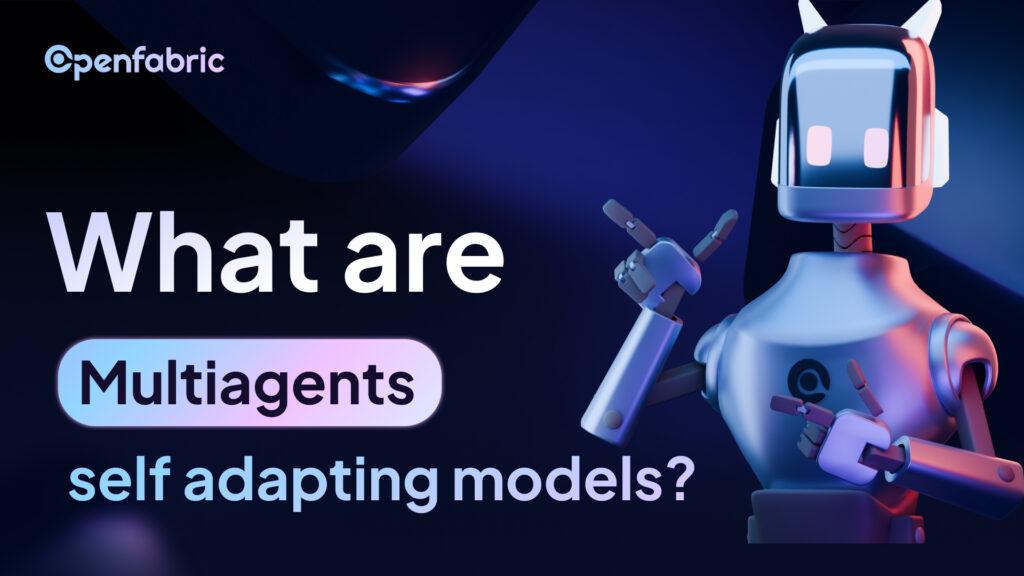
September 5, 2025 6 minutes read
What are multi-agent self-adapting models (MASA)?

Humans have a saying that experience is the best teacher. As such, it is often expected that people learn from their experiences. Whether those experiences were good or bad, this is the idea behind multi-agent self-adapting models.
However, these innovative AI solutions take it a step further. Before we go into that, let us highlight two major problems that AI developers have been trying to solve: ACCURACY and ADAPTABILITY. To a large extent, AI developers have been able to make AI as accurate as possible following rising concerns of inaccuracy in recent years. Making AI adaptable, however, has not been a walk in the park.
Driven by the need for systems to handle dynamic, uncertain environments and novel situations, the concept of AI adaptation started from evolutionary computation in the mid-20th century. In particular, evolution strategies and genetic algorithms. In the late 1990s, the industry welcomed the formalization of self-adaptive software. This involved early models of self-adaptation for parameters in genetic algorithms and the development of the MAPE-K (Monitor-Analyze-Plan-Execute-Knowledge) loop. These developments aided self-healing, self-optimizing, self-configuring, and self-protecting systems.
Fast forward to today, the field is increasingly leveraging Machine Learning (ML) and Large Language Models (LLMs) to enable more sophisticated and context-aware adaptations in complex systems like robots and software.
Recently, developers thought, “Why not have models that are both accurate and can adapt. This gave rise to the concept of multi-agent self-adapting models (MASA).
In this article, we will learn about these models and see how they benefit various industries.
Let’s dive in!
Overview of multi-agent self-adapting models
Multi-agent self-adapting models are AI systems that are made of multiple autonomous AI agents. Each agent is a small self-adapting model that is capable of observing its environment, processing data, and making decisions. To better enhance its future decisions, it learns from previous results and feedback from the results.
Together, these agents collaborate to achieve the best results and objectives. These models are inspired by how humans adjust their behavior based on feedback, new data, or environmental changes.
Multi-agent self-adapting models use distributed learning to achieve results that single AI models struggle to achieve.
How do multi-agent self-adapting (MASA) models work?
A lot of people may find this concept a little confusing because how can a model be multi-agentic and self-adapting all at the same time? The mechanism behind how these systems work is quite simple despite how complex they may seem. However, they work in a cycle of perception, decision-making, and communication.
First of all, let us disintegrate each agent and see them as a single agent first. Each agent operates autonomously and is equipped with the ability to perceive its environment through separate mechanisms like sensors or even signals from other agents. After this data is obtained, it is used for making decisions using reinforcement learning techniques. Therefore, allowing the models to learn strategies through trial-and-error interactions with their environment or through reward systems that take into consideration the long-term outcomes of the decisions. However, these decisions are optimized subsequently depending on the condition of the environment and the signals they get from other agents.
Now, as a multi-agentic team, each agent communicates with another and shares information using distributed learning. This helps them communicate faster and efficiently. They then provide feedback to each other through feedback loops, which helps them adjust without an external intervention.
In the end, the collective effort of the whole team is what produces the final result. However, each agent must agree and engage in strategic negotiation using game theory negotiation strategies.
What are the benefits of multi-agent self-adapting models?
Multi-agent self-adapting models allow various autonomous agents to adjust their behaviors to changing environments without central control. The benefits of these AI systems include:
Increased efficiency
Instead of a single AI agent handling one task, parts of the task are shared among the different AI agents in the model. As such, the processes are faster and streamlined. Imagine a printing company where AI handles production. While one group of robots handles printing of the pages, a separate group of robots may handle printing of the book covers. This saves time and increases the efficiency of an establishment.
Learning and adaptation in real-time
Usually, traditional AI agents require retraining to better fit their most current environment. Unlike those, MASAs do not require retraining because they learn on the job and adapt as they go. In addition, if there is any change in the condition they know, they quickly adapt and adopt new strategies that better suit the new conditions.
Decentralization
At the core of multi-agent self-adapting models is decentralized problem solving. Due to its multi-agentic nature, there is no single point of control or command. This also eliminates single points of failure or bottlenecks. Therefore, decentralization makes them flexible, reliable, and more durable in the face of attacks.
Scalability
The architecture allows for the addition or removal of agents. As such, the system can scale up or down to meet the level of demand from the environment, therefore allowing for maximum utilization of resources. As an autonomous system, it can scale naturally without losing its performance or needing retraining.
Improved performance
All the agents in a multi-agent self-adapting model collaboratively contribute to the overall intelligence of the system. Each agent specializes in different tasks and then shares information, resources, and learned experiences with others to make more accurate decisions. Since they work as a unit, this ability leads to overall better performance and drives innovation.
Real-world use cases of multi-agent self-adapting models.
MASA models are not a work of fiction; they are being used in various industries where they improve the efficiency of industry workflows. Let us see where these models are making an impact today:
Auto industry: self-driving cars are not just individual machines; they are composed of various AI agents that adapt to their environment in real-time and optimize their functions to better suit the state of the environment. This allows these vehicles to coordinate, choose the best routes, and prevent accidents.
Healthcare: the healthcare industry is complex, but still needs to move as a unit for a holistic approach to patient care. Therefore, MASA models assist in allocating resources, scheduling appointments, and tracking the progress of patients’ care. It provides a more collective overview of the workings of a hospital.
Gaming and entertainment: Video games show a very efficient use of MASA models. They use these models to create lifelike, adaptive main game characters and NPCs. Thus, allowing NPCs to adapt their behavior according to the player’s actions, making games more immersive and, well, fun.
Conclusion
Multi-agent self-adapting models are proof of the gradual shift of AI to better meet the optimization needs of end users and their environment. The real world is unpredictable, and these dynamic systems are the best fit for it. As companies continue going digital, MASA models will be at the core, with high chances of leaving behind those who won’t evolve.
Multi-agent self-adapting models are an innovation in the AI industry, and we can’t wait to see what next it has in store for us.
To evolve with AI, visit our WEBSITE today!

